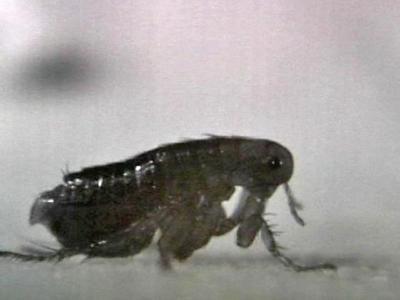
Probing the Lowly Flea Jump

The flea is a tiny creature that leave a mark wherever it bites.
But scientists in the UK say the flea could one day become a friend of man, thanks to the mechanisms that allow it to jump.
The insect has a spring structure in its legs and a protein called resilin, which helps it take off.
Malcolm Burrows, a professor of Zoology at Cambridge University, says the elastic protein could be used in heart surgery or to put a spring into a runner’s step.
[Malcolm Burrows, Zoology Professor, Cambridge University]:
“In using the energy stores, adapting those to things that we want to do, like running faster. Put this wonderful elastic in running shoes for example, or put this elastic, as my colleague Chris Elvin in Australia is doing, into glues, glues that can stretch. Then you can glue up hearts or stomachs and guts in operations, and the glue would expand and contract with the movements that these tissues undergo.“
Burrows worked together with research fellow and engineer Greg Sutton.
They filmed more than 50 jumps of ten fleas at 5,000 frames a second.
What they captured could provide technology companies with a blueprint for how to construct leg joints which can propel robots off the ground.
[Gregory Sutton, Research Fellow]:
“Oh well you could use it for interplanetary exploration or you could use it when a building collapses, you would send in jumping robots to look for survivors. You can use it to maneuver through mines or forests or through any numbers of terrains. If you wanted something that can move through some place that has not been paved.“
Previous research concluded that fleas jumped with their knees.
But the two men discovered the insect jumps with its feet, with the forces traveling through the foot, while the flea uses its legs as a lever system to process the energy from the spring to the animal’s body.
[Malcolm Burrows, Zoology Professor, Cambridge University]:
“This spring is a very interesting structure it’s made out of composite materials, made up of very soft elastic material and a hard material much in the way that cross bows were designed in the past. So it contracts the muscles slowly, stores energy, then it releases this energy very rapidly, and that’s what propels it from the ground.“
Burrows and Sutton may well have solved a four decade mystery of how fleas jump.
But they’re determined to find out more about the tiny insects.
They’re hoping to understand how the flea charges its spring and how it extends its legs at the same time helping it to accelerate in a millisecond.
The applications of such research they say, could be boundless.
 Foto: NTDTV
Foto: NTDTV




























vielen Dank, dass Sie unseren Kommentar-Bereich nutzen.
Bitte verzichten Sie auf Unterstellungen, Schimpfworte, aggressive Formulierungen und Werbe-Links. Solche Kommentare werden wir nicht veröffentlichen. Dies umfasst ebenso abschweifende Kommentare, die keinen konkreten Bezug zum jeweiligen Artikel haben. Viele Kommentare waren bisher schon anregend und auf die Themen bezogen. Wir bitten Sie um eine Qualität, die den Artikeln entspricht, so haben wir alle etwas davon.
Da wir die Verantwortung für jeden veröffentlichten Kommentar tragen, geben wir Kommentare erst nach einer Prüfung frei. Je nach Aufkommen kann es deswegen zu zeitlichen Verzögerungen kommen.
Ihre Epoch Times - Redaktion